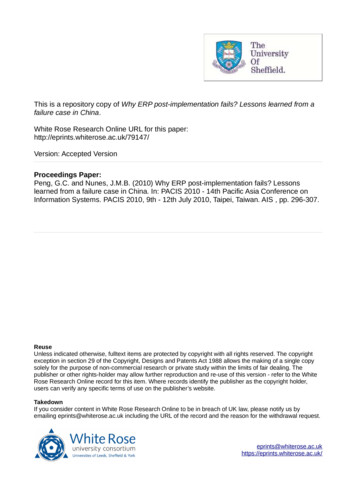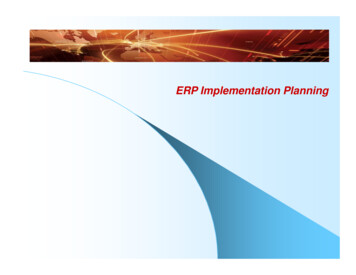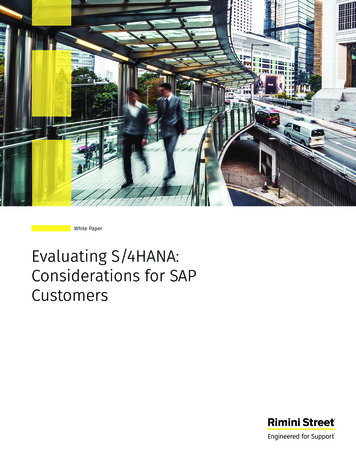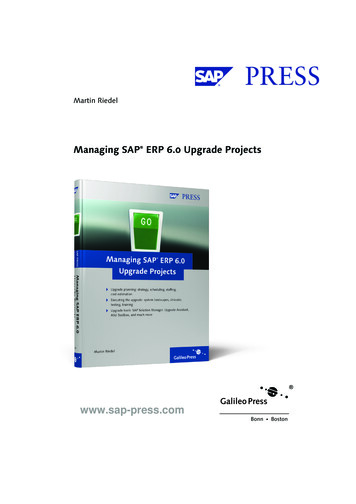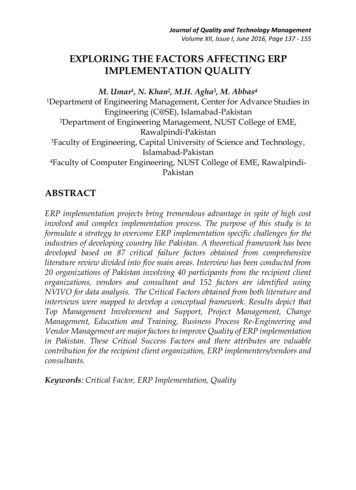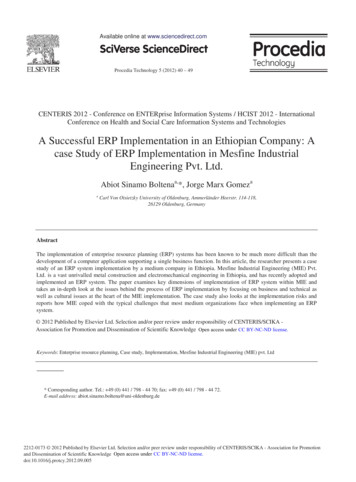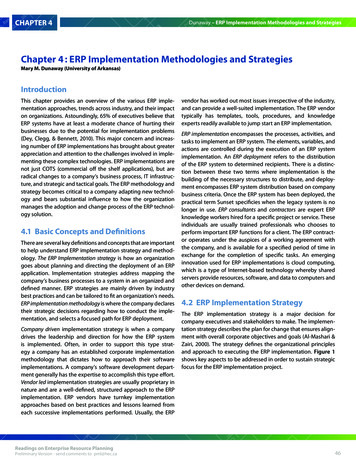
Transcription
DBR410Acc.Pay.CFacpr toryod ouc uttio pun tRm RawateriaC lCRFipr nishoDB d eductspr Ma COod ss 4uc re 1tio lean seorderDButPo roDB utp d.Dunaway – ERP Implementation Methodologies and StrategiesCRCRRevenueDBec.DBCRAcc.RCHAPTER 4Mprod Re D0luc e a 7tio seCProdor uctde ior nDBvendor has worked out most issues irrespective of the industry,and can provide a well-suited implementation. The ERP vendortypically has templates, tools, procedures, and knowledgeexperts readily available to jump start an ERP implementation.141CRDBERP implementation encompasses the processes, activities, andtasks to implement an ERP system. The elements, variables, andactions are controlled during the execution of an ERP systemimplementation. An ERP deployment refers to the distributionof the ERP system to determined recipients. There is a distinction between these two terms where implementation is thebuilding of the necessary structures to distribute, and deployment encompasses ERP system distribution based on companybusiness criteria. Once the ERP system has been deployed, thepractical term Sunset specificies when the legacy system is nolonger in use. ERP consultants and contractors are expert ERPknowledge workers hired for a specific project or service. Theseindividuals are usually trained professionals who chooses toperform important ERP functions for a client. The ERP contractor operates under the auspices of a working agreement withthe company, and is available for a specified period of time inexchange for the completion of specific tasks. An emerginginnovation used for ERP implementations is cloud computing,which is a type of Internet-based technology whereby sharedservers provide resources, software, and data to computers andother devices on demand.530Mpu Co E5rc nv 9Nha erse t toorderEx Mec Dut 01eMRP4.1 Basic Concepts and DefinitionsCpr Con O15od fiuc r mtionCRPo Ms IGre t go Oce oip dstsInre depqu eire ndm enen ttPuror chade serThere are several key definitions and concepts that are importantto help understand ERP implementation strategy and methodology. The ERP Implementation strategy is how an organizationgoes about planning and directing the deployment of an ERPapplication. Implementation strategies address mapping thecompany’s business processes to a system in an organized anddefined manner. ERP strategies are mainly driven by industrybest practices and can be tailored to fit an organization’s needs.ERP implementation methodology is where the company declarestheir strategic decisions regarding how to conduct the implementation, and selects a focused path for ERP deployment.5Crea VLte 01de NliveryInvestDBments413CashThis chapter provides an overview of the various ERP implementation approaches, trends across industry, and their impacton organizations. Astoundingly, 65% of executives believe thatERP systems have at least a moderate chance of hurting theirbusinesses due to the potential for implementation problems(Dey, Clegg, & Bennett, 2010). This major concern and increasing number of ERP implementations has brought about greaterappreciation and attention to the challenges involved in implementing these complex technologies. ERP implementations arenot just COTS (commercial off the shelf applications), but areradical changes to a company’s business process, IT infrastructure, and strategic and tactical goals. The ERP methodology andstrategy becomes critical to a company adapting new technology and bears substantial influence to how the organizationmanages the adoption and change process of the ERP technology solution.40IntroductionCRInvch enDB an torge yCRMary M. Dunaway (University of Arkansas)CRoDB raw ns.DBFipr nisod heuc dtChapter 4 : ERP Implementation Methodologies and Strategies4.2 ERP Implementation Strategy640Po Mst IROinvoiceCR/IR40DBGRCRt p y Version - send comments to pml@hec.cahInvesReadings on Enterprise Resource PlanningtmentsDBGR/IRDBInveso ntold rypr chod anuc getRco awns mum atept riaio lnsa Dole mre esve ticnuesDBRawmatCompany driven implementation strategy is when a companydrives the leadership and direction for how the ERP systemis implemented. Often, in order to support this type strategy a company has an established corporate implementationmethodology that dictates how to approach their softwareimplementations. A company’s software development department generally has the expertise to accomplish this type effort.Vendor led implementation strategies are usually proprietary innature and are a well-defined, structured approach to the ERPimplementation. ERP vendors have turnkey implementationapproaches based on best practices and lessons learned fromeach successive implementations performed. Usually, the ERPGoodsreceiptThe ERP implementation strategy is a major decision forcompany executives and stakeholders to make. The implementation strategy describes the plan for change that ensures alignment with overall corporate objectives and goals (Al-Mashari &Zairi, 2000). The strategy defines the organizational principlesand approach to executing the ERP implementation. Figure 1shows key aspects to be addressed in order to sustain strategicfocus for the ERP implementation project.46
DBR410Acc.Pay.CFacpr toryod ouc uttio pun tDButRm RawateriaC lCRFipr nishoDB d eductspr Ma COod ss 4uc re 1tio lean seorderPo roDB utp d.Dunaway – ERP Implementation Methodologies and StrategiesCRCRRevenueDBMprod Re D0luc e a 7tio seProdor uctde ior nInvestDBm141CRDBCash Project schedules Logisticsents305Cpr Con O15od fiuc r mtionCR Internal key subject matter experts External consultantsProjectRESOURCES Business proceses fit Integration Legacy systems Interfaces, data conversion and configurationCostallocation Budget FundingPuror chade ser4.2.1 Project Drivers5640PosRAcc.Pay.C40Po Mst IROinvoiceCR/IRDBCRBCRCaspututnnuesPreliminary Version - send comments to pml@hec.cahInvesReadings on Enterprise Resource PlanningtmentsDBGR/IRInveso ntold rypr chod anuc getDBRco awns mum atept riaio lnProject management includes the planning, organizing, timing,resourcing, and scheduling that define the beginning and end ofthe implementation. The establishment of project managementProject resources are integral for successfully carrying out thework designated by the ERP implementation methodology.Acquiring appropriate resources is one of many key decisionsin the implementation process. Whether individuals are internal key subject matter experts or external resources such asconsultants or contractors, the right skills and experience arerequired to meet project objectives. Not having the right resources working on the implementation project can be a disaster.The project resources contribute to assessing risks that couldimpede or delay implementation.GRCRmRawDBsa Dole mre esve ticnues4.2.2 Project Management404.2.3 Project ResourcesatProject drivers are important, and many times are lost in theimplementation effort. The reasons why the ERP system isbeing implemented and the expected benefits can shift dueto other company priorities and demands. For project success,it is important that strategic goals include clear reasons for theimplementation, and are kept at the forefront of the strategy. Itis crucial that management executives and project stakeholders establish expectations for the project. Their role is to ensurebroad business requirements are fleshed out, and projectobjectives are developed. Implementation methodologiesthat include project management processes are an essentialmechanism to sustain and accomplish the ERP implementationprocess.Po Ms IGre t go Oce oip dstsInre depqu eire ndm enen ttprepares the project team for the structure and control neededto keep the project on track. The role of project management inimplementation is critical. Many times, competing projects andunexpected issues arise that can derail the project implementation. Project management provides the process to monitor,derive solutions, and stay on track with the implementation.tEx Mec Dut 01eMRPExistingPlatforms,Systems,and DataGoodsreceipERP FunctionalModulesMpu Co E5rc nv 9Nha erse t toorder413ProjectMANAGEMENTCrea VLte 01de NliveryCRC Diagnostic view of why the ERP system is being implemented Cognizant of organizational demandsProjectDriversDBCRInvch enDB an torge yCRoDB raw ns.DBFipr nisod heuc dtFigure 1 - Key Aspects of an ERP Implementation Strategyt p F-53aymenec.DBCRAcc.RCHAPTER 447
DBR410Acc.Pay.CDButpr Ma COod ss 4uc re 1tio lean seorderRoDB raw ns.A company selects the ERP functional modules to implementbased on their business process requirements. The aim is toimplement an ERP solution that will provide a strategic advantage for the company. The ERP functional modules should fitthe business processes and be transparent across organizations.Integration of the business processes and functions, real-timedata, and information flow should appear seamless. Integrationcapability is the most recognized reason that companies choosean ERP system for implementation.141CRThe most common implementation methodologies may be jointventures with respect to industry, company driven, ERP vendorled, or a combination of company driven and ERP vendor led. Animplementation methodology can be company driven utilizinginternal software practices, or ERP vendor led where a designedmethodology for the implementation is used. Company drivenimplementation methodologies generally govern all softwareimplementations, irrespective of the type of project. Themethodology is generally flexible and can be adjusted to suitthe needs of a particular type of software project. ERP vendorshave their own proven methodology that is used repeatedly forcustomer ERP implementations. The vendor led ERP methodology may also require minor changes or to be tweaked to satisfya company’s implementation requirements.A company’s existing platforms, systems, and data are the lifeline of the ERP implementation. The implementation strategyshould address how the legacy system environment will behandled respective of the new ERP system. Data may need tobe converted for use in the ERP system, interfaces will possiblyneed to be developed to bridge data from the legacy system,and configuration rules established for operational transactionprocessing. Transition from legacy systems can be one of themost difficult challenges in the ERP implementation. Greatdetail, major planning, and careful execution are needed toensure smooth changeover and to “sunset” systems.Mpu Co E5rc nv 9Nha erse t toorderEx Mec Dut 01eMRP5Cpr Con O15od fiuc r mtion4.2.5 Existing Platforms, Systems, and Data30CashDBCRInvestDBments413Crea VLte 01de NliveryCRProdor uctde ior nDBCCRIt is important for companies to analyze the ERP implementation method, since the risk of failure in ERP implementation issubstantial and can be a highly expensive ordeal. Typically,companies will follow a specific methodology framework todeploy an ERP system. A methodology is used to structure, plan,and control the process of implementing the ERP system. Themethodology may include tools, templates, specific deliverables and artifacts created and completed by the ERP projectteam. A methodology can be thought of as the roadmap wherethe real work for the implementation begins.CRERP systems are one of the most costly technology initiativesthat an organization can implement. The total cost of ERPownership includes the packaged ERP software, hardware,professional services (consulting, on-going maintenance,upgrades, and optimization), and internal costs. Therefore, it iscrucial to define the appropriate budget and funding sourcesfor implementing the ERP solution. The duration of the projectand payback periods is important to determine the expectedreturn on investment (ROI). According to the 2011 Panoramareport, the majority of implementations will “pay back” in lessthan three years. They also show that the average implementation project cost can range from 1.1 million to 5.0 million,depending on the type of ERP solution and vendor.540t406Goodsreceip/IRt p F-53aymenDBPosRAcc.Pay.C40Po Mst IROinvoiceGRCRThe Supply Chain consortium is a premier example of jointventure collaboration. The consortium provides a broad rangeof tools, events, and processes to members in order to driveworld class performance. A key focus of the consortium is tohelp companies deliver necessary business processes that haveproven superior results in real world implementations.CRBCRCaspututnnuesPreliminary Version - send comments to pml@hec.cahInvesReadings on Enterprise Resource PlanningtmentsDBGR/IRInveso ntold rypr chod anuc getRco awns mum atept riaio lnsa Dole mre esve ticnuesDBRawmatFunding sources should be well-developed to avoid majorfinancial challenges along the way. A contingency or fall-backplan to address shortcomings or budget overruns should bein place to minimize project schedules and logistics. Budgetoverruns are certainly more of a reality than an exception. Mostbudget overruns are due to unanticipated or underestimatedfees, staffing, or technical issues. Evaluating and developingcontingency for these concerns prior to software implementation can minimize the cost and duration of the project.Joint ventures are collaborative implementation strategies among similar companies across a particular industry.Companies typically participate in consortiums with othersimilar companies to work in partnership to address economic concerns, performance impacts, technology, outsourcing,value creation, operations, and many other topics to enhancecompany performance. The consortiums are a source for benchmarking and best practices that can assist with creating thestrategic advantage, and enable better support for clients byaligning with key industry stakeholders. Moreover, the interaction exchange facilitates the sharing of technology implementation strategies useful for ERP system implementations.Po Ms IGre t go Oce oip dstsInre depqu eire ndm enen ttPuror chade ser4.3.1 Joint VentureCR4.2.6 Cost AllocationDBInvch enDB an torge y4.3 ERP Implementation MethodologiesDBFipr nisod heuc dt4.2.4 ERP Functional Modulesm RawateriaC lCRFipr nishoDB d eductsCRPo roDB utp d.Dunaway – ERP Implementation Methodologies and StrategiesMprod Re D0luc e a 7tio seFacpr toryod ouc uttio pun tCRRevenueDBec.DBCRAcc.RCHAPTER 448
DBR410Acc.Pay.CDButpr Ma COod ss 4uc re 1tio lean seorderRCProdor uctde ior nCRoDB raw ns.CRDB1DBCR41Considerable ERP success can be gained when both thecompany driven and ERP vendor led are combined for an implementation. The best practices of both types of implementation strategies are used to tailor the implementation needsbest suited for a company. If a vendor led or a hybrid of vendorled and company driven methodology is used, considerationsshould be addressed to determine the specific resource rolesand how they will be used. Establishing where the resources areobtained, their roles, and responsibilities is important for ERPimplementation success. Company driven and ERP vendor ledcombine the best-suited components of each methodology tofit the project goals. This combination will formulate a methodology that captures the strengths in areas where weakness mayexist.Project management is a key area where companies like to usetheir own methodology and practices. For their ERP implementation, large telecom company Omantel, chose to capitalizeon their strong matrix project structure, and assigned projectmanagement responsibility to its in-house project managementoffice (Maguire, Ojiako, & Said, 2009). This gave the Omantel teamleaders full responsibility for the overall project and supportingroles to the ERP vendor. This approach did not work as expected.The implementation efforts appeared to be working in parallel.The situation created conflict and was remedied by reorganizing into one team.4.3.3 ERP Vendor Led54.4 ERP Deployment Strategies40CRBCRCaspututnnuesPreliminary Version - send comments to pml@hec.cahInvesReadings on Enterprise Resource PlanningtmentsDBGR/IRDBPosRAcc.Pay.Ct p F-53aymen40Po Mst IROinvoiceCR/IRDBRco awns mum atept riaio lnInveso ntold rypr chod anuc get6GoodsreceiptCompanies typically choose the best approach to carry outthe implementation, utilizing several well-known and popularimplementation strategies which include big bang, phasedrollout, parallel adoption, and a combination of phased-rolloutand parallel adoption. Deciding which strategy to deploy istypically based on a company’s business objectives, budgetconstraints, available resources, and time sensitivity. Each implementation strategy has its strengths and weaknesses which arefurther discussed in detail.GRatCRmRawDBsa Dole mre esve ticnuesNike, Inc. partnered with i2 Technologies, Inc., a softwareintegration vendor for its supply chain implementation. Theimplementation did not turn out as planned. The responsibility was on the integration vendor to provide the implemen-40Po Ms IGre t go Oce oip dstsInre depqu eire ndm enen ttPuror chade serMpu Co E5rc nv 9Nha erse t toorderEx Mec Dut 01eMRPMany ERP vendors have developed their own proprietyimplementation methodology. ERP implementation methodology includes extensive templates, roadmaps, blueprints,and tools. ERP vendors such as Oracle, SAP and Microsoft haveestablished methodologies that are used for their ERP implementations. For example, the ASAP methodology developedby SAP provides an Implementation Assistant which allows acompany to choose from several roadmap types and varietiesto meet implementation needs. Oracle combines its implementation methodology and strategy into an approach known asApplication Implementation Methodology (AIM). The methodology is a basic framework which includes a vast number oftemplates to support the tasks performed during ERP implementation. Their methodology can be tailored and applied tomost any specific situation. Microsoft has developed Sure Step,a structured approach for implementing its ERP solution. TheSure Step methodology provides detailed guidance about theroles required to perform activities and proven best practices.It covers the complete implementation in addition to phases foroptimization and upgrade.30Most companies have a department that performs development, support, and maintenance of its software applications.Typically, companies have a process in place to govern howsoftware applications are developed, maintained, and deployed.The methodology is based on company established objectivesand requirements. An ERP implementation is a type of projectmost likely included and governed by these processes. Usually,a company has standard processes that are well understood andcan be relied on. Nevertheless, it is always possible to deviatefrom the standard process when necessary.5Cpr Con O15od fiuc r mtionCrea VLte 01de Nlivery4.3.2 Company Driven4.3.4 Combined Company Driven and ERPVendor LedCRInvestDBments413CashCRInvch enDB an torge ytation methodology. They recommended that Nike “followtheir guidelines for implementation” using their proprietarytemplates and roadmaps. Despite the vendors’ proven successwith 1,000 companies, the project failed.DBFipr nisod heuc dtThe consortium is led by executives from such Fortune 500companies as Kraft Foods, Target, The Coca-Cola Company,Hallmark, and Miller Coors. Their collaboration efforts focusacross many initiatives, industry segments, and topics. Forexample, this consortium has a data collection of over 11,000benchmark and best practice data points, key informationabout near term priorities in technology, and a PeerNet wheremembers can share functional expertise that fosters directexchange of technology best practices.m RawateriaC lCRFipr nishoDB d eductsCRPo roDB utp d.Dunaway – ERP Implementation Methodologies and StrategiesMprod Re D0luc e a 7tio seFacpr toryod ouc uttio pun tCRRevenueDBec.DBCRAcc.RCHAPTER 449
DBR410Acc.Pay.CDButpr Ma COod ss 4uc re 1tio lean seorderRCProdor uctde ior n141CRA variation of the Big Bang approach is to combine it with aphased implementation approach (discussed later). This entailsa series of “mini-bangs” that affect logical functions of thebusiness. One example uses the mini-bang methodology todeploy the ERP system division-by-division, where each divisionof a company uses a Big Bang to migrate to the new ERP systemfor manufacturing plant operations. A second example mightuse a functional approach ; where appropriately interfacing bothsystems running their parts of the company, i.e. finance goes firstwith the new system across all divisions at one time, followed bymanufacturing and human capital management. Typically thistype of strategy encompasses one to three modules at a timefor the deployment.DB30Below is a list of pros and cons applicable to the mini and bigbang implementation strategy :Mpu Co E5rc nv 9Nha erse t toorder Implementation pain points and challenges are morepronounced post go-livePo Ms IGre t go Oce oip dsts All training is completed for users before the initial rolloutGoodsreceipt ERP system go-live happens on a planned dateConsPo Mst IROinvoiceCR40 Fall-back to legacy system may be more difficult thanoriginally perceivedPosRAcc.Pay.C Pronounced dip in performance after the implementationt p F-53aymen A failure in one area of the system could affect othersCRBCRCaspututnnuesPreliminary Version - send comments to pml@hec.cahInvesReadings on Enterprise Resource PlanningtmentsDBGR/IRDBCR Employees are constrained to learn the new system forthe designated implementation dateDBatGR/IR Details may be overlooked in the rush to changemRawDBInveso ntold rypr chod anuc getRco awns mum atept riaio lnsa Dole mre esve ticnues40 Cost can be much lower than a longer drawn-out implementationInre depqu eire ndm enen ttThe downside of the big bang implementation approach is thatthe project is often rushed, details are overlooked, and changesto business processes may not be the best ones for the organization. The big bang strategy’s significant “pain points” are dueto its hectic nature. More often than not, projects that implement an overly aggressive big bang approach are more risky,and can result in less satisfaction with the system’s abilities to5Puror chade ser Implementation time is shorterThe appeal of the big bang implementation strategy is that itfocuses the organization for an intense and relatively shorterperiod of time than if the project were phased. This often helpsto address long-term resource shortages, condenses the implementation project into a defined period of time, but the painand challenge of the ERP project are more noticeable using thisapproach.Enterprise visibility capabilities are more salient, thereforeidentify integration functionally issues early on with the use ofthe new system.PROS6Ex Mec Dut 01eMRPJust as the name implies, big bang can be described as a strategy to implement all enterprise functionality and ERP modulesin a single instance as a major event (Mabert et al., 2003). Allusers move to the new system at a determined date, and areimplemented across the entire organization at once during aplanned go-live event. This can be a large implementation acrossmultiple countries, multiple business divisions or product lines,and generally affects the entire organization. After implementation activities have been successfully executed, and “lights out”on the old system is achieved ; the new ERP system is launched.Reverting back to the legacy environment becomes quitechallenging if at all possible. It is necessary to have documentedfall-back plans just in case the initial changeover to the new ERPsystem is a failure.5Cpr Con O15od fiuc r mtion4.4.1 Big-Bang40Cash4.4.2 Mini Big-BangCRInvestDBmentstimesensitivityCrea VLte 01de DB raw ns.CRDBInvch enDB an torge yBusinessobjectivesmeet important business requirements. The most common criticism of the big bang implementation method is the risk factor.The risk is significant due to the number of things that couldgo wrong with an instant changeover execution. However, theimplementation can potentially be quick and less costly than along, drawn-out phased approach.DBFipr nisod heuc dtFigure 2 - ERP deployment decisionsm RawateriaC lCRFipr nishoDB d eductsCRPo roDB utp d.Dunaway – ERP Implementation Methodologies and StrategiesMprod Re D0luc e a 7tio seFacpr toryod ouc uttio pun tCRRevenueDBec.DBCRAcc.RCHAPTER 450
DBR410Acc.Pay.CDButpr Ma COod ss 4uc re 1tio lean seorderRm RawateriaC lDBThe phased rollout by module is the most common phasedrollout strategy. The structure of the ERP system is modular innature, where each application module automates the processes within certain functions of the business. Common ERP application modules include accounts payable, purchasing, studentenrollment, general ledger, inventory, and benefits administration to name a few. Phased rollout by module is by far the mostpopular technique where ERP modules are strategically implemented one at a time. Core ERP modules are generally integrated first, followed by other modules where business processesare highly integrated. This technique helps the company ensurethat modules are working as per department needs.141CRDBThis type of roll-out may delay the whole process and bringabout complexities during implementation. Generally, interface programs are required to bridge the gap between legacysystems and the new ERP system until the new ERP systembecomes fully functional. Typically, business process functionsrequired for tactical operations are considered first, followedby adding each module and functionality with each phase.Many implementation experts recommend the General Ledgermodule, or perhaps less mission-critical modules to begin theimplementation process.Ex Mec Dut 01eMRPMpu Co E5rc nv 9Nha erse t toorderPros Lessons learned can be utilized for successive phasedrollouts30The downsides are that these types of phased projects oftenlack the intense urgency and focus of a big bang project. It canalso lead to “change fatigue,” which can cause employees tobecome burned out on new initiatives over a sustained periodof time (Garside, 2004). Instead of completing the project withina shorter period of time, projects involve constant changeover longer periods, which can be draining to employees. Ofcourse there are several options, including many variations andcombinations of these implementation techniques. Just like bigbang, a phased-rollout strategy has advantages and disadvantages. A few of the common opinions are listed below :5Cpr Con O15od fiuc r mtionCRPROS Provides the ability to meet the needs of departments Ample time for adjustments to planned deployment Increased project team members implementation skillsfor continued rollouts Less risk405Puror chade ser Step by step approach to implementation Change management impact potentially less than with abig bang implementation strategyPo Ms IGre t go Oce oip dstsCons Less urgency as a big bang rolloutCONS Continous change over a longer period of time Longer implementation timelineGoodsreceipt Fallback to legacy system becomes more difficult ifrequired May generate more integration complexities Large number of technical resources to create interfaceprogramsPosBCRCaspututnnuesPreliminary Version - send comments to pml@hec.cahInvesReadings on Enterprise Resource PlanningtmentsDBGR/IRDBInveso ntold rypr chod anuc gett p F-53aymenThis approach is similar to the modular approach, the difference being that the main consideration of the business priority phased rollout is the need for urgency. The business prioritymay turn out to be a modular implementation strategy oncebusiness priority is established.40Po Mst IROinvoiceCRDBPhased Rollout by Business PriorityRRco awns mum atept riaio lnsa Dole mre esve ticnuesDBWithin a phased-rollout implementation ERP systems can bestructured using a few different techniques such as by ERPmodule, company business unit, company business priority orgeographical location. Each of these techniques is based on acompany’s strategic business goals, timeline, and resources.Acc.Pay.CCRRawmatGR/IR Temporary solutions to legacy issues are created tosupport phased-rollout Employee change fatigue6 Delayed integration of whole business processesCRInre depqu eire ndm enen tt More time for user to adapt to new system40Crea VLte 01de NliveryInvestDBments413CashCRProdor uctde ior nDBCCRoDB raw ns.Another strategy which focuses on phasing in modules a fewat a time for a slower implementation approach is the phasedrollout (Mabert et al., 2003). The phased-rollout strategy encompasses implementation of the ERP system that occurs in smallincrements over phases for longer periods of time. Users moveonto the new systems in a series of planned steps. The idea isthat project teams are allowed to take their time in the planning,business process mapping, customization, and testing of thesystem while continuing with day-to-day job responsibilities.Invch enDB an torge yPhased Rollout by ModuleCRPhased-RolloutFipr nisod heuc dtCRFipr nishoDB d eductsCRPo roDB utp d.Dunaway – ERP Implementation Methodologies and StrategiesMprod Re D0luc e a 7tio seFacpr toryod ouc uttio pun tCRRevenueDBec.DBCRAcc.RCHAPTER 451
DBR410Acc.Pay.CFacpr toryod ouc uttio pun tProdor uctde ior n May generate more integration complexitiesCR411For example, the ERP system implementation can begin withsubsidiary organizations, specific business products or servicefunctions, or joint business operations. Some companies puttogether a team that travels between each business unit andlocation to complete the implementation. As the team gainsmore experience with each implementation, subsequentrollouts become more efficient. This method has better employee acceptance, and despite a longer process time, the risk islower.DB Closely aligns to unique company’s business goals5Cpr Con O15od fiuc r mtionPros30Cash Limits the scope of the implementationCR
Readings on Enterprise Resource Planning Preliminary Version - send comments to pml@hec.ca 46. Chap r P4 Imp This a Rer TPmlaEov,aaRE eydoE Iml e l Ima o z.iA Imn ebeuEe Rer l%x Ipm lxi 5 oyap Ipp. iompM rduSssSw(iDmp IpI 4 4 wfuEe Rer eydo oyap




